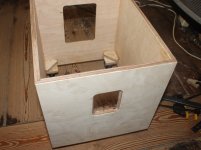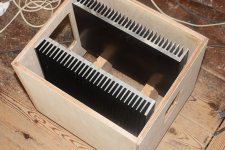thank you sir tinitus...do your have any circuit recommended for me sir.. i have 38 0 38 VAC transformer rated at 10ampere..and 2 filter capasitor..
PSU for BA1000 stereo.
68V * 1.41 = 95.9 V
Not very much safety margin for the electrolytics. Don't forget we need to calculate with highest possible AC voltage which may be easily up to 10% higher as nominal voltage:
(68V +10%) * 1.41 = 105.5 V
IMHO using secondary 2x68V AC you need to take absolute minimum 120V electrolytics in this PSU to be safe.
BR, Toni
Use double bridge 35A in parallel 🙂
IMHO if you stack electrolytics you need to add power resistors in parallel to ensure the voltage is halfed. But better to avoid this topology strictly for safety reasons. 😱
at this voltage and also high current flow while operating mode the caps will start to cook after a short time.Dual bridge PSU
This sounds similar to the heatpipe heatsink noise in older amps from Luxman but the capacitors goes very hot. This is to avoid in all cases.
check out the 160V versions of follow series:
http://www.ftcap.de/tl_files/ftcap/datenblaetter/elektrolyt/G2012.pdf
If only half the capacity value is achieved due to small space (e.g. 4.7mF instead 10mF) you haven't a significant disadvantage.
For details you lead at best a phone call by ftcap in Husum, Germany. Here you will get the necessary experience and knowledge.
Introduce additional resistors arround 0,22 Ohm between the first cap and the second - both in the pos. and the neg. rail to reduce charging current peaks. This step will provide better sound quality.
I would add bypass caps between 10uF and 25uF like this:
http://www.wima.de/DE/snubbermkp.htm
For the discharge resistor I would choise for each rail two 27 K-Ohm, 7W in serial mode to avoid hot spots.
For the rectifiers I would prefer discrete diodes - go to
http://www.semikron.com/
http://www.semikron.com/skcompub/de/technical_explanation_discretes.pdf
Last edited:
at this voltage and also high current flow while operating mode the caps will start to cook after a short time.
I suppose you mean when used above their specced voltage 😕
well, maybe it would have been easier for all if specced amp output had been into 4ohm load
btw, are anyone here actually thinking of using it for serious PA ?
I mean the circuit from post #284, where is 65VAC in use. This means a DC from 65x1,4 resp. 65+26 = 91VDC.I suppose you mean when used above their specced voltage 😕
well, maybe it would have been easier for all if specced amp output had been into 4ohm load
btw, are anyone here actually thinking of using it for serious PA ?
100V is too little, also 160V is actually too little, because while a high ripple current flow it is not enough to only pay attention to the Voltage value of the cap (check out the ripple current flow by a speaker load at 1 ohms, 2 ohms and 4 ohms at this supply voltage so as the internal impedance of the caps - then you will get the power loss inside of the cap).
Please note additional, that the nominal impedance (which is written on the speakers - e. g. 4 ohms or 4-8 ohms) is not the smallest occurred impedance at the same time. This means only the average value. An example therefore is the good known Infinity Kappa 8 and Kappa 9 - go to
http://cdn.avsforum.com/d/db/500x1000px-LL-db964a8e_090801082656_kappa9.jpeg
Last edited:
ASTX is correct.68V * 1.41 = 95.9 V
Not very much safety margin for the electrolytics. Don't forget we need to calculate with highest possible AC voltage which may be easily up to 10% higher as nominal voltage:
(68V +10%) * 1.41 = 105.5 V
IMHO using secondary 2x68V AC you need to take absolute minimum 120V electrolytics in this PSU to be safe.
BR, Toni
Some of Apex's suggestions for voltage rating of the smoothing caps is irresponsible.
A 220:68+68Vac transformer feeding 100Vdc rated capacitors is potentially dangerous.
Even a 230:68+68Vac transformer for 100Vdc caps is risking a blow up.
A 240:68+68Vac 4% regulation when fed with 254Vac results in ~105Vdc on the smoothing caps, when the amplifier load is disconnected or turned down to low output bias operation.
ASTX is correct.
Some of Apex's suggestions for voltage rating of the smoothing caps is irresponsible.
A 220:68+68Vac transformer feeding 100Vdc rated capacitors is potentially dangerous.
Even a 230:68+68Vac transformer for 100Vdc caps is risking a blow up.
A 240:68+68Vac 4% regulation when fed with 254Vac results in ~105Vdc on the smoothing caps, when the amplifier load is disconnected or turned down to low output bias operation.
I only give suggestions,companies with commercial products are irresponsible, they usually use 100V rated caps with 70V ac.
I only give suggestions,companies with commercial products are irresponsible, they usually use 100V rated caps with 70V ac.
Planned obsolescence ...
Planned obsolescence ...
I also mean that, but some brand caps work over 20 years without obsolescence. Some brand caps can work with 20% higher voltage than rated.
I also mean that, but some brand caps work over 20 years without obsolescence. Some brand caps can work with 20% higher voltage than rated.
A manufacturer of quality parts has it's own safety margin. So a 100V elko may withstand 120V but there is no guarantee.
You can not give suggestions on "hope that every device has this hidden safety margin".
BTW: correct voltage margin does not be the only criterion to select caps for a power supply as "tiefbassuebertr" correctly said. This amp and it's PSU are working at very high and letal power/voltage levels so there should always be extra safety margin.
BR, Toni
depends on how you read the figures/numbers
to me it means actual measured ac voltage on trafo, unloaded and with no smoothing
so far I have not read about any suggestions to go buy a certain specific trafo or cap
if you guys wants to take responsibility of every member here you will be very busy in the future
to be careful and take caution is very good ofcourse
please note I suggested using standard 55+55V trafo
to me it means actual measured ac voltage on trafo, unloaded and with no smoothing
so far I have not read about any suggestions to go buy a certain specific trafo or cap
if you guys wants to take responsibility of every member here you will be very busy in the future
to be careful and take caution is very good ofcourse
please note I suggested using standard 55+55V trafo
Here is responsible suggestion: use transformer 2x50v ac , 100V rated caps with 10 pairs of MJL21195/96 or MJL4281/4302 it's safe.
I will use 66+66V
and will probably never use much of its power anyway
I have trafos
but should I go buy trafos, they would surely be 50 or 55V
and that is measured on raw trafo
when apex shows it with caps, it is ofcourse measured with caps
but since amp is not shown connected, I would expect it is raw power supply measured unloaded
also says 220V mains
so if you have 230V mains, it should still be the same trafo voltage
errors occur ofcourse
but hope you are not suggesting a complete noob handholding here
or suggesting that this amp should be designed 100% noob safe
but yes, surely we need to be very careful with what we do, absolutely
all positive suggestion to make it safe are good
making it into a personal vendetta is not
and btw, many thanks to Mile for staying, and not throwing the towel so easy
and will probably never use much of its power anyway
I have trafos
but should I go buy trafos, they would surely be 50 or 55V
and that is measured on raw trafo
when apex shows it with caps, it is ofcourse measured with caps
but since amp is not shown connected, I would expect it is raw power supply measured unloaded
also says 220V mains
so if you have 230V mains, it should still be the same trafo voltage
errors occur ofcourse
but hope you are not suggesting a complete noob handholding here
or suggesting that this amp should be designed 100% noob safe
but yes, surely we need to be very careful with what we do, absolutely
all positive suggestion to make it safe are good
making it into a personal vendetta is not
and btw, many thanks to Mile for staying, and not throwing the towel so easy
ASTX is correct.
Some of Apex's suggestions for voltage rating of the smoothing caps is irresponsible.
A 220:68+68Vac transformer feeding 100Vdc rated capacitors is potentially dangerous.
Even a 230:68+68Vac transformer for 100Vdc caps is risking a blow up.
A 240:68+68Vac 4% regulation when fed with 254Vac results in ~105Vdc on the smoothing caps, when the amplifier load is disconnected or turned down to low output bias operation.
what country has that high supply voltage?
i might be not well informed but highest ratings i could find at devices was 235V,others were either 220 or 110/115Vac.
it is better to have some safety margins but i have placed four "Iskra" 2200uF 40V capacitors to a straight 40Vdc PSU and that thing worked for aboutfive years with no trouble at all,later i replaced a transformer for a lower secondary voltage and since than that capacitors work at 36Vdc per rail.
one more thing- tolerance of +10% means that total tolerance is 20% (because there always is a minus side of tolerance) wich is even in my country non-tolerant.
i say again:it is better to have larger safety margin,but also i have seen a lot of 20+years working APEX amplifiers that never had to be repaired (just cleaned from dust) and haven´t heard that anyone ever had that big troubles (such is capacitors pop-up) with them.
Last edited:
Also may I suggest: do not make this amp. Why would you ever want to do that. Nevertheless many do it yourself builders have already done this amplifier, with previous experience they had no complaints about the functionality or sound quality.
https://en.wikipedia.org/wiki/Mains_electricity_by_country
Every builder that works with mains voltage must be responsible for their own work.
First rule taught is to keep in mind your safety and the safety of others.
Every builder that works with mains voltage must be responsible for their own work.
First rule taught is to keep in mind your safety and the safety of others.
Last edited:
- Home
- Amplifiers
- Solid State
- 1000W Simple PA Amplifier



